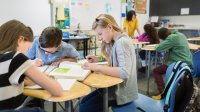4 Strategies for Building Content Knowledge
Elementary students need rich content knowledge to become better readers and to be able to engage in project-based learning.
Your content has been saved!
Go to My Saved Content.Elementary school teachers pave the way for their students to be able to take part in rigorous project-based learning (PBL) down the line by ensuring that students develop foundational reading skills. This comes through phonics and vocabulary work, which helps students build content knowledge across disciplines.
Unfortunately, schools don’t always emphasize the importance of building content knowledge.
For instance, Jessica Winter argues in The New Yorker that reading instruction is often anchored to skill development and strategic guessing without rich content knowledge and intentional development of academic vocabulary in subjects such as science and social studies. A curriculum that is built strictly on high skill development, high collaboration, and high strategic guessing equates to what she calls a “vibes-based literacy.”
As a former high school science teacher, I found that students struggled to think critically about something that they didn’t have thorough knowledge of to begin with. The solution is to provide students with rich content knowledge to read, write, and talk about in class.
Rigorous PBL
Rigorous PBL is an inquiry-based approach that follows a specific pathway of enabling students to develop three levels of learning:
- Surface (I know ideas or skills),
- Deep (I can relate ideas and/or skills), and
- Transfer (I can apply ideas or skills in multiple contexts).
Rigorous PBL is built on the understanding that knowledge of subject areas is critical to successful learning across the levels of rigor. It also requires an equal intensity and integration of all three levels, and this is developed when students routinely engage in tasks that require reading, writing, and talking. For maximum effect, these activities should be addressed by ensuring that teachers are following best practices anchored in the science of reading.
Science of Reading and Rigorous PBL
Within rigorous PBL, students need content knowledge development to effectively learn how to read, write, and talk. Without surface-level knowledge, students are unable to access deep and transfer learning within and across subjects. Studies have shown that skills don’t transfer without a rich content basis in which these skills can link.
Common approaches to PBL fall short of building and deepening content knowledge. Often the main culprits are ideologies that assume students will not be motivated by content or will lose a sense of power by having to engage in direct instruction. The results are a “vibes-based PBL methodology” built on teaching skills such as problem-solving, collaboration, and research without the necessary knowledge to successfully meet all levels of complexity.
Rigorous PBL, however, is based on the idea that knowledge is power, and we must design and teach strategies to not only activate but embed content knowledge.
Moreover, rigorous PBL is based on the concept of balance. We need to bring learning to read and reading to learn together for students in early grades, and we need to deepen their content knowledge.
4 Strategies to Increase Content Knowledge
1. Position skill and knowledge learning intentions and success criteria side by side. Ensuring that students are clear on expectations of learning has been well documented in a myriad of research studies and books. The question is to what degree are the expectations we provide to students balanced between content and skill expectations? This is especially critical when we are in a literacy block. As journalist and author Natalie Wexler writes in The Atlantic, content should be embedded when we learn literacy.
Let’s help students see the need for literacy skills in fully accessing the knowledge we are learning. Skills should be considered our tools for answering our “need to knows” within and across disciplines.
Place content-based outcomes next to skill outcomes in your unit plans, on rubrics, and when co-constructing clarity with students.
2. Embed social studies and science into literacy-informed inquiry units. Often, in elementary schools, we have literacy blocks that range from 30 to 100 minutes of instruction. In rigorous PBL, the suggestion is to incorporate the direct teaching of science and social studies within those blocks by doing the following:
- Conducting interactive read-alouds that embed content syntactically a few grade levels ahead. The teacher reads the passage, students reread, and brief summaries are discussed in think-pair-shares.
- Building academic vocabulary with students and incorporating the use of that vocabulary when previewing texts, reading text, and discussing the text after reading a passage.
- Providing students with content-rich books in which to read and write about daily.
3. Use deep learning strategies to think aloud about content. Getting students to talk about content is really important. Using protocols such as fishbowls, discussion mapping, four As, and final word protocols enable students to understand and consolidate information.
Because it is far easier to talk about what we read than the actual process of reading and writing, protocols should be considered a potential precursor to reading and for debriefing our reading. This goes for writing as well.
As students are engaging in these routines, teachers should prompt students to use academic language in their discussions.
4. Infuse writing into routine tasks. “Thinker’s block” gets in the way of writing. That is, students struggle with writing when they don’t have much to write about. When students encounter rich content-based reading and talking, there’s a great opportunity for them to engage in the process of writing.
Moreover, we need to build writing as a habit that’s infused into the everyday lives of students. One strategy to consider is quick writes to predict what students will be reading, sharing an opinion on a piece that they are reading, and summarizing and reflecting on a piece of reading.
Making learning content a daily habit of reading, writing, and talking is critical for students to develop all three levels of complexity and is an essential ingredient of rigorous PBL.
